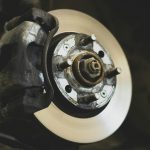SERIOUSLY, A BRAKE FLUID FLUSH?!?
Brake fluid attracts moisture, over time moisture creeps into the brake hydraulic system and can cause serious problems (especially on today’s cars with anti-lock brakes). What happens is the moisture gets into the system and not only causes rust and corrosion in the lines, but it can also reduce the boiling point of the brake fluid and this can cause the fluid to boil inside the caliper causing brake fade.
We had a customer come in for the typical brake job (pads & rotors) and upon the test drive the vehicle pulled to the left and we could tell that something was not right. After checking the calipers for sticking in their slides we eventually found contamination in the brake hydraulic system. When the caliper pistons pushed back in, it literally stirred up the dirt and sediment inside the caliper which kept the pistons from moving freely. The pictures below is of the inside of the brake system and the piston, showing the debris that had accumulated inside the lines causing the problem.
Another repair we make on a regular basis is the replacement of steel brake lines, some of which are rusted and broken from the inside. A brake fluid flush keeps new fluid in the system and greatly decreases the lines from rusting from within and removes debris.

Did you know that neglecting your brake fluid can lead to a 25% decrease in braking efficiency? Yes, you read that right. Your car’s brake system is crucial for your safety on the road, and maintaining the brake fluid, along with other maintenance items, is a key part of ensuring it functions optimally. A brake fluid flush might sound like just another unnecessary expense, but it plays a vital role in keeping you safe behind the wheel.
When was the last time you had your brake fluid, braking performance, and other items checked? Stay tuned as we delve into why a brake fluid flush is not something to ignore and how it can save you from potential accidents down the road.
Brake Fluid Basics
Purpose
Brake fluid flush is crucial to maintain the efficiency of your braking system and ensure safety on the road. Fresh brake fluid plays a vital role in transmitting force from the brake pedal to the wheels. Neglecting a brake fluid change can lead to brake failure and compromised safety.
Composition
Common components of brake fluid include glycol ethers and borate esters.
Glycol ethers attract moisture, while borate esters resist it, maintaining a stable composition.
Different types of brake fluids like DOT 3, DOT 4, and DOT 5 have varying compositions to suit specific vehicles.
Degradation Signs
Visible signs of degraded brake fluid include dark color, indicating contamination with dirt and debris. Spongy brakes or a soft brake pedal are common symptoms of deteriorated brake fluid. Ignoring these signs can result in reduced braking performance, brake failure, and potential safety hazards.
Importance of Flushes
Safety Enhancement
Regular brake fluid flushes are crucial for enhancing safety on the road. Fresh brake fluid ensures optimal braking efficiency. The quality of brake fluid directly impacts the responsiveness of your vehicle’s brakes. Maintaining high-quality brake fluid is essential to meet safety standards and prevent accidents.
A brake fluid flush helps in maintaining the optimal performance of your vehicle’s brakes. Over time, old brake fluid can lead to decreased braking responsiveness. By regularly flushing the brake fluid, you ensure that your brakes function efficiently when needed. This maintenance not only enhances performance but also contributes to a smoother driving experience.
Flush Necessity
Contamination Issues
Brake fluid quality can be compromised by common contaminants like dirt, moisture, and air. These contaminants, including old fluid, enter the brake system through worn-out seals or improper handling during maintenance. The presence of these contaminants can lead to a decrease in brake fluid efficiency.
Contaminated brake fluid can result in corrosion within the braking system, damaging crucial components such as calipers and cylinders. This corrosion can compromise the overall performance of the braking system, leading to potential safety hazards for the vehicle and its occupants. To prevent contamination issues, it is essential to regularly inspect the brake fluid for any signs of contamination and adhere to recommended flush intervals.
Moisture Problems
Moisture plays a significant role in brake fluid degradation, causing a reduction in its boiling point and overall effectiveness. When moisture enters the braking system, it can lead to vapor lock during heavy braking situations, resulting in a spongy brake pedal feel and reduced stopping power. Addressing moisture problems promptly is crucial to maintaining optimal braking system performance.
The presence of moisture in brake fluid can significantly impact braking system efficiency by promoting rust and corrosion within the system. This can lead to brake line failure or decreased responsiveness when applying the brakes, posing serious safety risks. To combat moisture problems, consider using high-quality brake fluids with low water absorption properties and storing them properly in sealed containers.

Flush Process Explained
Preparation Steps
Before diving into a brake fluid flush, ensure you have the necessary tools and materials ready. Start by gathering a brake fluid, a wrench, a turkey baster or syringe, and a container to collect the old fluid. Proper preparation is crucial as it sets the foundation for a successful flush.
To begin, park your vehicle on a level surface and engage the parking brake. Next, open the hood and locate the brake fluid reservoir. Clean the area around the reservoir to prevent any debris from contaminating the system during the flush.
Remember, safety first! Always wear protective gloves and goggles to shield yourself from any potential splashes of brake fluid. Keep some rags handy to wipe up any spills promptly. These preparation steps are essential for a smooth and efficient brake fluid flush process.
Execution Details
Now that you’re prepared, let’s dive into executing a brake fluid flush with precision. Start by loosening the bleeder screw on one wheel using a wrench. Attach a clear tube to the bleeder screw and place its other end in a container with some fresh brake fluid.
Next, have an assistant slowly pump the brake pedal several times while you monitor the fluid coming out of the bleeder screw. Keep an eye out for any air bubbles in the expelled fluid; this indicates air in the system that needs to be flushed out completely.
Once you observe clear, bubble-free fluid coming out consistently, tighten the bleeder screw securely and move on to repeat this process for each wheel. Remember to check the brake fluid reservoir periodically during the flush and top it up with fresh fluid as needed.
During this process, ensure that you follow proper safety precautions such as wearing protective gear and handling brake fluid carefully due to its corrosive nature. By paying attention to these key checkpoints and following each step diligently, you’ll achieve a thorough and effective brake fluid flush.
Identifying Flush Needs
Visual Clues
Inspect brake fluid regularly for clarity and color; dark or cloudy fluid indicates contamination and requires flushing. Check the brake fluid reservoir for proper levels and any signs of leaks.
Look for a brownish tinge in the brake fluid, which signifies moisture contamination, necessitating a flush to maintain braking efficiency. Use a clean rag to wipe the dipstick and observe any residue or particles present in the fluid.
Visualize the difference between fresh, clear brake fluid and old, contaminated fluid through side-by-side comparisons. Utilize reference images or diagrams to understand the ideal versus compromised brake fluid appearance.
Performance Cues
Notice a spongy or soft brake pedal feel when applying pressure, indicating air bubbles or moisture in the brake system that require flushing to restore optimal performance. Experience extended stopping distances or reduced responsiveness when braking.
Understand that degraded brake fluid can lead to overheating of brakes due to decreased boiling point, resulting in potential safety hazards. Recognize instances where brakes feel less effective or produce unusual noises during operation as signs of deteriorating brake fluid quality.
Examples include experiencing brake fade during prolonged braking, where the pedal becomes less responsive over time due to overheated brakes caused by old brake fluid. Another cue is encountering vibrations or pulsations when applying brakes, signaling potential issues with the braking system that may necessitate a flush.
DIY vs Professional Service
Skill Requirements
To perform a brake fluid flush at home, basic skills like following instructions and using tools are essential. Understanding safety precautions is crucial. For advanced techniques such as pressure or vacuum bleeding, knowledge of brake systems and mechanics is required. Resources like online tutorials and workshops can aid in developing these skills for brake fluid maintenance.
Equipment Needs
Essential equipment for a brake fluid flush includes a wrench, turkey baster, clear tubing, and new brake fluid. Each tool serves a specific purpose: the wrench for opening bleeder valves, the turkey baster for removing old fluid, and the clear tubing for connecting to bleed screws. Professional flushes may require specialized equipment like pressure bleeders or diagnostic tools.
Timing Your Flush
Mileage Guide
Brake fluid flushes are recommended every 30,000 miles to maintain optimal braking performance. Factors like driving conditions and vehicle age can influence the frequency of flushes. Following a mileage guide ensures safety and prevents costly brake system repairs.
Regular fluid flushes prevent moisture buildup, which can lead to corrosion in the brake system. Neglecting this maintenance can result in decreased braking efficiency and potential safety hazards. By adhering to the recommended mileage intervals, you ensure your brakes function effectively.
Here is a side by side example of new brake fluid and some fluid that was flushed from a car during a routine brake system flush – please note all of the debris that has settled to the bottom of the used brake fluid bottle. It is a small cost to prevent serious unforeseen braking problems when you need to stop, but this sediment can be deadly for your braking system and must be removed regularly. We recommend flushing the brake fluid every 30 – 40,000 miles for not only the longevity of your braking system parts, but for the safety of your family.
